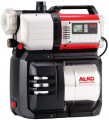Max. pressure
The highest pressure that the pump is capable of creating during operation. This parameter is directly related to the maximum head (see above); however, it is less obvious, and therefore, it is indicated rarely.
Suction type
The main division in this parameter is related to whether the pump can remove air from the suction line. This, in turn, determines the features of starting the unit.
— Self-priming. Self-priming pumps include all pumps that do not require the complete absence of air in the suction line at startup — it is enough that the pump itself is filled with water. Accordingly, such models are less demanding and normally tolerate air entering the line. However, this requires a reliable design that can normally withstand water hammer, which accordingly affects the cost of the unit.
— Priming. Pumps with this device can only work normally when both the unit body and the suction line are filled with water. If air enters the line, it must be removed or the pump will not be able to start normally. Such models are not as convenient as self-priming ones; at the same time, they are noticeably cheaper, and with the normal quality of the water supply system, there is practically no significant difference between the two varieties.
Maximum particle size
The largest particle size that the pump can handle without problems. This size is the main indicator that determines the purpose of the device (see above); and in general, the larger it is, the more reliable the device, the lower the risk of damage if a foreign object enters the suction line. If the risk of the appearance of too large mechanical impurities is still high, additional protection can be provided with filters or grids at the inlet. However, such a measure should be considered only as a last resort, because from constant exposure to solid particles, the grids become clogged and deformed, which can lead to both clogging of the line and filter breakthrough.
Volume of water pressure tank
The volume of the water pressure tank provided in the design of the pressure tank unit.
A water pressure tank is a reservoir capable of holding a certain volume of water. It performs several functions at once. The main ones are: firstly, maintaining a stable pressure; secondly, protection against water hammer; and thirdly, storage of an “emergency” supply of water in case of a power outage, pump breakdown, etc. The larger the volume of this tank, the better it handles its capabilities; on the other hand, a large capacity significantly affects the dimensions and cost of the tank. Therefore, it does not always make sense to look for a pump with the maximum volume of the water pressure tank. Specific recommendations on choosing the optimal volume for different situations can be found in special sources.
Power cord length
The length of the cable that supplies electricity to the pump with the appropriate type of power supply (see above). The longer the cable the farther from the socket or other power source you can install the pump. This parameter is especially important for submersible models: if the cable is too short, it will simply be impossible to lower the pump to the maximum depth provided for by its design, because ordinary extension cords cannot be immersed in water.
Water pressure tank material
The material of the water pressure tank provided in the design of the pumping station.
Recall that the classic (not sewer) pumping station is a surface pump, supplemented by a water pressure tank. Such a tank is a reservoir where water accumulates. It performs two functions: it smooths out pressure drops in the system and stores some water in case the pump is turned off. For the main body in such containers, the following materials can be used:
— Cast iron. The simplest and most inexpensive option: cast iron is somewhat inferior to stainless steel in terms of strength and corrosion resistance. However, for those models in which it is used, these moments do not have a noticeable meaning.
— Stainless steel. The most advanced material in use: stainless steel combines high strength and corrosion resistance. However, such tanks are somewhat more expensive than other varieties.
— Steel. Non-stainless steel accumulators usually use special coatings to protect against corrosion. This material is superior to cast iron in strength and is somewhat cheaper than stainless steel.
— Aluminium. The main advantage of aluminium alloys is their light weight combined with quite decent strength and rust resistance. Of the shortcomings, a rather high price can be noted.

